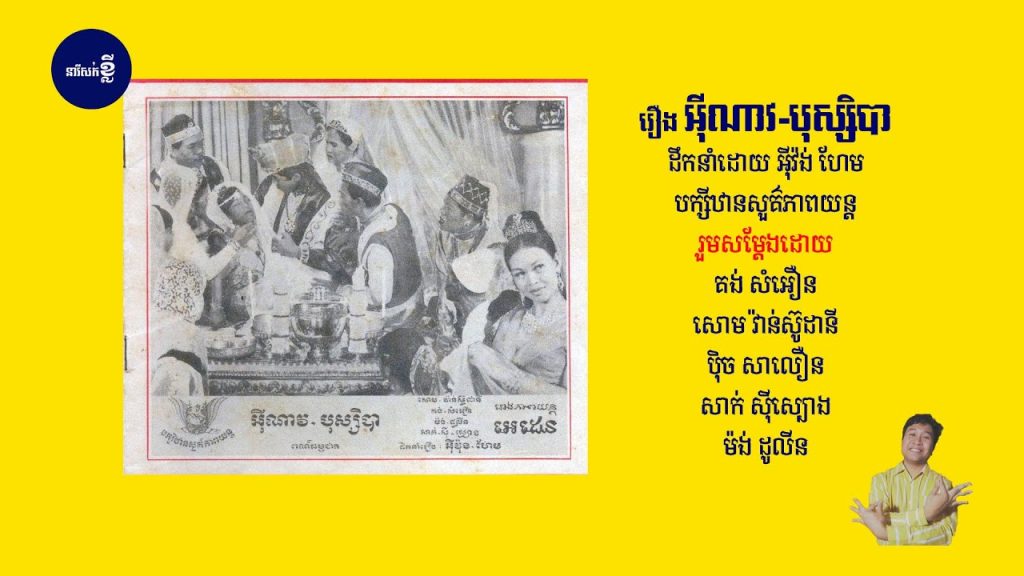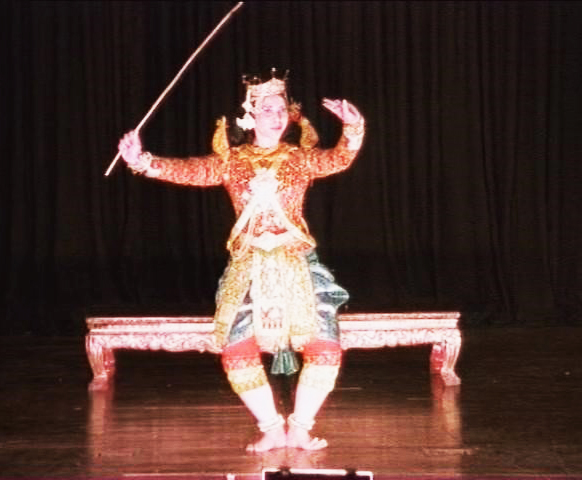ប្រទេសកម្ពុជាជាប្រទេសដែលមានប្រវត្តិសាស្ត្ររុងរឿងច្បាស់លាស់ និងវប្បធម៌ដ៏សម្បូរបែប។ ដិតដាននិងភស្តុតាងនៃឧបករណ៍តន្ត្រីនិងអ្នករបាំ ត្រូវបានគេឃើញមាននៅលើចម្លាក់នៃប្រាសាទសិលាជាច្រើនពាន់ទូទាំងប្រទេស ជាសក្ខីភាពនៃវប្បធម៌ និងអរិយធម៌ដ៏អស្ចារ្យនៃសម័យអង្គរ (ស.វ. ទី៩-១៥)។ ភស្តុតាងទាំងអស់នេះ ក៏ឆ្លុះបញ្ចាំងផងដែរពីសម័យហ្វូណន (ស.វ. ទី១-៥) និងសម័យចេនឡា (ស.វ. ទី៦-៨)។ ក្នុងចំណោមរឿងដែលបានឆ្លាក់លើប្រាសាទមានដូចជា រឿងមហាភារតៈ រឿងរាមកេរ្តិ៍ និងរឿងកូរសមុទ្រទឹកដោះជាដើម។ ចម្លាក់អប្សរា (ស្រីទេពអប្សរ នាដការីរបាំ) ដែលមាននៅពាសពេញតាមប្រាសាទជាច្រើនក្នុងប្រទេសកម្ពុជា មានចំនួន ១,៧៨៧ គឺជាតឹកតាងនៃសារៈសំខាន់នៃ តន្រ្តីនិងរបាំក្នុងជីវិតមនុស្សក្នុងព្រះបរមរាជវាំង។
វីរកថា និងរឿងជាច្រើនត្រូវបានគេប្រើជាប្រធានបទក្នុងការ អភិវឌ្ឍសិល្បៈ ទស្សនីយភាពនិងការសម្តែងរបស់ខ្មែរ ដែលក្នុងនោះមានរឿងមហាភារតៈ រឿង រាមកេរ្តិ៍ រឿងជាតក រឿងព្រេង រឿងសរសេរថ្មី និងរឿងអ៊ីណាវ ជាដើម។ល។ ទោះបីជាមិនត្រូវបានគេស្គាល់ដូចរឿងរាមកេរ្តិ៍ ឬរឿងជាតកក៏ដោយ រឿងអ៊ីណាវ ត្រូវបានគេសម្រួលទៅជាច្រើនទម្រង់សិល្បៈ មានដូចជាល្ខោនបាសាក់ របាំព្រះរាជទ្រព្យ (អ៊ីណាវ៖ យ៉ារ៉ាន់ដេញក្ងោក ផលិត ដោយ សំ សំអាង ក្នុងឆ្នាំ២០០២) និងភាពយន្ត (អ៊ីណាវបុស្សិបា ដឹកនាំរឿងដោយ អ៊ីវង់ ហែម ក្នុងឆ្នាំ១៩៦៨ មានគង់ សំអឿននិងសោម វ៉ាន់សូដានី ជាតួសម្តែង)។

រឿងអ៊ីណាវ ឬ រឿងអ៊ីណាវបុស្សិបា ជារឿងមួយដែលព្រះមហាក្សត្រខ្មែរ សព្វព្រះរាជហឫទ័យខ្លាំងណាស់ ជាពិសេសរវាងអំឡុងឆ្នាំ១៩០០ដល់ឆ្នាំ១៩៤០។ នាសម័យបច្ចុប្បន្ន គេពុំសូវឃើញមានសម្តែងរឿងនេះឡើយ។ រឿងអ៊ីណាវដែលខ្ញុំយកមកអធិប្បាយនៅពេលនេះ គឺដកស្រង់យកត្រង់ឈុតយ៉ារ៉ាន់ដេញក្ងោក។
ថ្ងៃមួយនៅក្នុងព្រៃ ស៊ីយ៉ាក្រា ជាព្រះរាជបុត្ររបស់ព្រះបាទដាហា បានឃើញសត្វក្ងោកមួយដែលទេវតាបញ្ជូនមកឱ្យឃើញជាប្រផ្នូលថា ព្រះអង្គនឹងបានជួប ជុំក្រុមគ្រួសារ ដែលព្រះអង្គបានបែកឃ្លាតអស់រយៈពេលជាយូរយាណាស់មកហើយ។ ព្រះអង្គព្រមទាំងអស់ពួកពលសេនា បានដេញតាមចាប់សត្វក្ងោកនោះរហូតទៅដល់ព្រំដែនប្រទេសកាឡាំង។ ក្លែងប្រាណជាយ៉ារ៉ាន់ ព្រះអង្គបានជួបនឹងឧត្តមសេនីយ៍ ប៉ាន់យី និងប្អូនប្រុសឈ្មោះសង្ខាមោតា ហើយក៏ឱ្យគេជួយនាំព្រះអង្គទៅសូមបម្រើ ព្រះមហាក្សត្រ។ ក្រោយមក យ៉ារ៉ាន់ បាននៅបម្រើព្រះមហាក្សត្រ ព្រមទាំងបានទទួល ងារជាមន្ត្រីជាន់ខ្ពស់ម្នាក់ផង។
រឿងអ៊ីណាវ សឹងតែបាត់ពីប្រទេសកម្ពុជា។ រឿងអ៊ីណាវ ដែលនៅមាននោះគឺ យោងទៅតាមការចងចាំរបស់អ្នកសម្តែងដែលបានរស់រានមានជីវិតម្នាក់ ដែលដើរតួ យ៉ារ៉ាន់ពីមុនមក គឺ “យ៉ារ៉ាន់ដេញក្ងោក”។ ក្នុងឆ្នាំ២០១០ ព្រះរាជបុត្រីព្រះរៀម នរោត្តម បុប្ផាទេវី ជាមួយនឹងនាដករនាដការី និងសាស្រ្តាចារ្យរបាំបានសាកល្បងបង្កើត ឡើងវិញនូវរឿងអ៊ីណាវដើម្បីសម្តែងក្នុងព្រះរាជពិធីចម្រើនព្រះជន្មសម្តេចតា នរោត្តម សីហនុ។
រឿងអ៊ីណាវ-ប៉ាន់យី៖ លំនាំរឿងរបស់ខ្មែរ
ចាប់តាំងពីបានបញ្ចូលក្នុងសិល្បៈខ្មែរមក រឿងអ៊ីណាវ-ប៉ាន់យី ត្រូវបានគេសម្រួល ពីទម្រង់ដើមរបស់ខ្លួន។ ក្នុងប្រទេសកម្ពុជា រឿងនេះត្រូវបានគេជឿថាមានប្រភពពីជ្វានិង អារ៉ាប់។ រឿងព្រេងនេះត្រូវបានសម្រួលដំបូងក្នុងប្រទេសកម្ពុជានៅឆ្នាំ១៩៦៥ ដោយ ព្រះមហាក្សត្រិយានី ស៊ីសុវត្ថិមុនីវង្ស កុសុមៈនារីរ័ត្នសេរីវឌ្ឍនា ក្នុងឱកាសដំណើរទស្សនកិច្ចរដ្ឋរបស់អតីតប្រធានាធិបតីនៃសាធារណៈរដ្ឋឥណ្ឌូណេស៊ី លោកស៊ូការណូ។
ក្នុងលំនាំរឿងរបស់ខ្មែរ រឿងអ៊ីណាវ-ប៉ាន់យី អ៊ីណាវ គឺជាព្រះអង្គម្ចាស់នៃនគរ ដាហា និងបុស្សិបា ជាព្រះនាងនៃនគរអាឌែន។ រឿងនេះពណ៌នាពីការភ្ជាប់ពាក្យរបស់ក្សត្រទាំងពីរអង្គ ដែលត្រូវបានព្រះបិតាព្រះមាតារៀបចំ។ ព្រះអង្គម្ចាស់អ៊ីណាវ ជឿងប់ងល់នូវអ្វីដែលនារីកំណាន់របស់ព្រះអង្គទូលប្រាប់ ហើយក៏បដិសេធមិនរៀប អភិសេកជាមួយ ព្រះនាងបុស្សិបា ដែលមានព្រះទ័យស្រឡាញ់ព្រះអង្គយ៉ាងខ្លាំង។ ព្រះមហាក្សត្រត្រមួយអង្គបានឆ្លៀតឱកាសលើស្ថានភាពមួយនេះ ក៏សុំរៀបអភិសេក ជាមួយព្រះនាងបុស្សិបា ហើយថែមទាំងគំរាមថានឹង លើកសង្គ្រាមមកប្រសិនបើព្រះនាង មិនព្រម។ ក្រោយមក អ៊ីណាវ ដឹងខ្លួនថាព្រះអង្គមានព្រះទ័យស្រឡាញ់ព្រះនាងបុស្សិបា ដែលធ្វើឱ្យស្រីកំណាន់របស់ព្រះអង្គមានភាពច្រណែន ដែលបានប្រើសិល្ប៍ដាក់ បណ្តាសារលើអ៊ីណាវឱ្យក្លាយទៅជាមនុស្សគមខ្នងហើយគម្នាក់។
រឿងអ៊ីណាវ-ប៉ាន់យី៖ របាំព្រះរាជទ្រព្យខ្មែរ
ដំណើររឿងរបស់ខ្មែរ ចាប់ផ្តើមពីយ៉ារ៉ាន់ដេញក្ងោក ដែលបន្ទាប់មកព្រះអង្គ បានធ្វើដំណើរទៅកាន់នគរកាឡាំង។ ប៉ុន្តែក្នុងការសម្តែងរបាំព្រះរាជទ្រព្យនាពេលបច្ចុប្បន្ន ដំណើររឿងតាមដាននូវពិធីរាជាភិសេកជាព្រះរាជាកិត្តិយសថ្វាយ អ៊ីណាវ និងចរិកា។ បុស្សិបាដែលអន់ព្រះទ័យ បានរៀបចំគម្រោងដើម្បីបំផ្លាញពិធីរាជាភិសេក នោះ។ នៅចុងបញ្ចប់ អ៊ីណាវនិងបរិវាររបស់ព្រះអង្គបានក្លែងបន្លំកំបាំងខ្លួន ហើយរត់គេចចូលទៅក្នុងព្រៃ។

បន្ទាប់ពីសម័យខ្មែរក្រហមប្រល័យពូជសាសន៍ប៉ុលពត (១៩៧៥-១៩៧៩) មកការខិតខំប្រឹងប្រែងត្រូវបានធ្វើឡើង ដើម្បីអភិរក្ស អភិវឌ្ឍ និងផ្សព្វផ្សាយពីសិល្បៈ ទស្សនីយភាពនិងការសម្តែងរបស់ខ្មែរ។ រឿងអ៊ីណាវ-ប៉ាន់យី ត្រូវបានគេស្គាល់តិចជាងគេ ក្នុងចំណោមរឿងឯទៀតៗ ដោយរឿងនេះត្រូវបានគេរៀបចំឡើងតែមួយដងមួយកាល ក្នុងទម្រង់សិល្បៈខ្មែរតែប៉ុណ្ណោះ។
ជាលទ្ធផល យើងប្រឈមនឹងការបាត់បង់។ ទៅអនាគត យើងត្រូវបំផុសការខំប្រឹងប្រែងរបស់យើងឱ្យកាន់តែច្រើនឡើង ដើម្បីរក្សាឱ្យបាននូវភាពរស់រានមានជីវិតឡើងវិញ និងបន្តរឿងអ៊ីណាវ-ប៉ាន់យី ឱ្យរឿងនេះលូតលាស់ និងទទួលបាននូវវត្តមានក្នុងចំណោមរឿងនិងទម្រង់សិល្បៈល្បីល្បាញផ្សេងៗទៀតនៅកម្ពុជា៕
——————————
THE STORY OF INAV “The Khmer Version, Epic, and Story in the Development of Khmer Arts”
Cambodia is a country that is known for its rich history and culture. Scores of musical instruments and dancers can be seen in carvings on over a thousand ancient stone monuments across the country, attesting to the great culture and civilization of Angkor (9th-15th centuries CE). Evidence of this goes as far back as the Funan (1st-6th centuries CE) and Chenla (6th-8th centuries CE) periods. Among the stories carved on these monuments were the Mahabharata, the Ramayana (Reamker in Khmer) and the Churning of the Ocean of Milk. Scattered throughout the various temples across the country are carvings of 1,787 Apsara figures (court maidens of dance and music), a testament to the importance of music and dance in the life of the court (Cravath 2007: 13). Many epics and stories have been used as themes in the development of Khmer visual and performing arts, including the Mahabharata, the Reamker (Ramayana), the Jataka tales, folktales, newly written stories and the story of Inav. While less known than the Reamker or the Jataka tales, the story of Inav has been adapted to various art forms, including folk theatre (Basakk), court dance (Inav: Yarann Pursuing the Peacock, produced by Sam-Ang Sam in 2002) and film (Enav Boss Bar, directed by Yvong Hem in 1968 and starring Kong Sam-Oeun and Som Vann Sodany).
Of Javanese origin, Roeurng InavorRoeurng Inav Bussiba remained one of the Khmer king’s favorite stories, frequently featured in the 1900s to the late 1940s, but rather lesser known today. Our dance masters refer to this excerpt as “Yarann’s Pursuit of Peacock.” Dancers’ kbach or movements contain remarkable foot-work, and they are accompanied by melodious singing.
One day in the forest, Prince Siyakra (son of King Daha) sees a peacock-like creature sent by tevoda as a sign that he will meet members of his family from whom he has long been separated. The prince and his party pursue the bird until it disappears on the border of the Kingdom of Kalaing. In disguise as Yarann, the prince meets General Panyi (Panji) and his adopted brother Sangkhamorta and asks to be introduced to the king as a servant. They arrange the audience and eventually Yarann gains favor and a high military rank. General Panyi continues to be his friend, as does Sangkhamorta.
The story of Inav is almost lost in Cambodia. One of the only remaining pieces of Inav, according to the memory of a performer who survived who played Yarann in the past, is “Yarann Pursuing the Peacock.” In 2010, Princess Buppha Devi, together with dancers and professors, tried to recreate the dance of Inav to perform on the occasion of the King Father Norodom Sihanouk’s birthday.
Inav-Panyi: The Khmer Version
Since its introduction to Khmer arts, the Inav-Panyi story has been adapted from its original form. In Cambodia, it is believed that the tale came from the Arab region (Committee for Research and Documentation of Royal Ballet 2008: 91). While it is clear that Inav-Panyi is a tale of Javanese origin, the depiction of what Cambodians believe to be Muslim elements in Inav led to the belief that its origins were Arabic. This may be explained by a general tendency to regroup Javanese and Arabic in a more general Muslim context, in the same way that anything Western may often be referred to as French by the Khmer. This legend was first adapted in Cambodia by H.M. Queen Sisowath Kossamak Nearyrath Serey Vaddhana in 1965, on the occasion of the state visit of Indonesia’s former president, Sukarno.
In the Khmer version of the Inav-Panji story, Inav is the prince of the palace of Daha and Bussiba is the princess of the palace of Aden. The plot tells the story of their engagement agreement, arranged by their parents. Prince Inav naively believes whatever his mistress says and thus refuses to marry Princess Bussiba who loves him very much. Another king takes advantage of the situation and asks for Bussiba’s hand in marriage, threatening to wage war if she refuses. Later, Inav realizes that he is deeply in love with Bussiba, which arouses the jealousy of his mistress, who then uses magic to cast a spell on Inav, turning him into a mute hunchback.
Inav-Panyi: Khmer Court Dance
The plot of the Khmer story begins with Yarann pursuing a peacock, which subsequently leads him to the kingdom of Kalaing. However, in present‑day court dance performances, the plot follows an elaborate wedding feast in honor of Inav and Charika. An upset Bussiba then plans to destroy the wedding. In the end, Inav and his company disguise themselves and seek exile in the forest.
Following the Khmer Rouge period (1975-1979), efforts have been made to conserve, develop, and promote Khmer visual and performing arts. As the Inav-Panyi story is less known than others, it has only been staged periodically in a few art-forms. As a result, much of the Khmer version’s story has been lost over time. We must multiply our efforts in order to ensure the survival of the story of Inav-Panyi so that it may continue to evolve and to eventually gain importance amidst other more popular stories and art-forms. It would seem as though Kampong Cham and Kampong Chhnaing, where reside Cambodia’s largest Muslim communities, would be an ideal location for research as it is the only place where the story of Inav seems to have been preserved (Committee for Research and Documentation of Royal Ballet 2008: 90).
អត្ថបទដើម៖ បណ្ឌិត សំ សំអាង






